Which cookbooks inspire a chef?
by Mary Bailey
Which cookbooks do chefs deem to be essential in the kitchen? What books were important to their careers? What do they do with cookbooks they love and what are they reading right now? Several of Edmonton’s best chef shared their favourite cookbooks and recipes inspired by them. Read on, their answers may surprise you.
ANDREW FUNG, NINETEEN
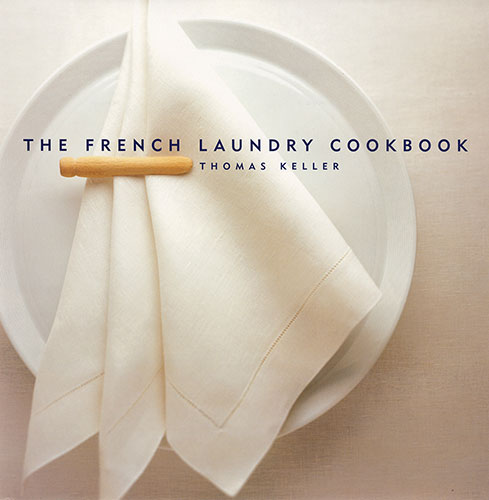
The French Laundry Cookbook is essential in the kitchen.
I look at the recipes for all those dishes, still innovative, modern and forward thinking. It comes down to lifestyle, how they grow things in the Napa Valley and how to be an ethical chef. The French Laundry reminds me of Larry Stewart at the Hardware Grill because it’s about the fundamentals of cooking, how the foundation needs to be strong before you can build on top of it. My first thing in cooking school in Vancouver was how to cook an egg. What we think is easy is usually the hardest.
A lot of young chefs are going to Copenhagen now, maybe I’m a bit more old school. When I was living and training in Switzerland, I became inspired by a series of books called The Culinary Chronicles, especially #6 Best of Germany and Switzerland. In the Chronicles they talk to chefs about the ingredients, where is the food coming from, how they cook and taste, how they run their restaurants and how they enjoy life.
Salmon Tartare Bombay
| 130 g | fresh wild salmon |
| 1 t | red onion, finely chopped |
| 1 t | capers, roughly chopped |
| 1 t | cilantro, finely chopped |
| ¼ t | each curry powder, turmeric |
| ½ | lemon, juiced |
| ⅓ t | Dijon mustard |
| 1 T | olive oil |
| salt and pepper to taste | |
| mini papadum | |
| 1 | cucumber, thinly sliced |
Finely dice salmon and reserve in fridge until needed.
Mix all ingredients except lemon juice, salt and pepper.
Bake papadum until bubbly but not coloured. Mix tartare with lemon juice and season with salt and pepper. Arrange cucumber in a ring or fan. Top cucumber with tartare and garnish with papadum disks.
Serves 4.
CHRISTOPHER HYDE, UCCELLINO
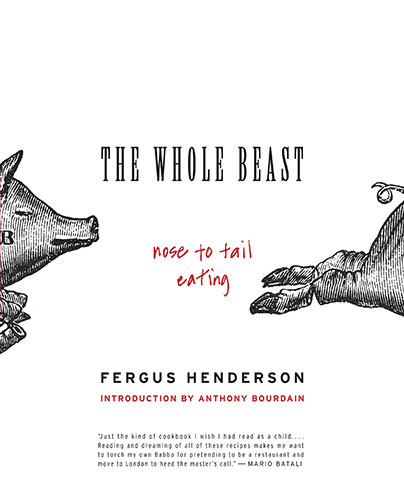
My most favourite book is Fergus Henderson’s The Whole Beast nose to tail eating. I love this book and refer to it often to be inspired. Being Australian I grew up with British-style cooking so it’s like coming home to read. It came across the sea with me. Another book I love is Origin: The Food of Ben Shewry. It’s like the Noma book, with tightly-plated, pretty-looking dishes, sometimes so involved that it becomes a book you look at just for visual stimulation.
A book I have loved since I was 13 years old is the River Café Cookbook, the blue book, beautiful, simple, rustic Italian food with such great ingredients. It put me on the path to cook Italian food. I like Made in Sicily by Georgio Locatelli too.
A book gives me an idea. They give me life when I read them and overwhelm me with inspiration. When I look at a photo or read a recipe, something pops into my head and I think that would be really very cool; like the octopus carpaccio we did this summer at Uccellino.
Smoked Eel with Bacon and Mashed Potatoes
“Being Australian I love working with seafood. I would love everyone to eat more eel, give them something comfortable yet keep them on the edge of their seat. I generally stay close to this Fergus Henderson recipe.” –Christopher Hyde, head chef, Uccellino
| 1 | whole smoked eel, reasonably large |
| 4¼-4½ lbs | floury potatoes, such as Idaho russets, peeled and halved |
| sea salt | |
| 2½ c | milk |
| 1½ sticks | (12 T) unsalted butter plus an extra knob |
| freshly-ground black pepper | |
| 6 rashers | smoked streaky bacon, sliced thick |
To prepare your eel, first lay it down with its back facing you. With a sharp knife cut behind its head until you feel the backbone, then run your knife along the bone to the tail. Turn over and repeat. To remove the skin, simply slip your fingers under it and run gently along the fillet. Cut both fillets into 3 pieces. (Smoked eel is also available packaged in fillets.)
Boil your potatoes until soft in salted water. Heat the milk and butter, then add to the drained potatoes and mash. Season with salt and pepper, remembering that the bacon is quite salty.
Heat a frying pan and add the knob of butter. Place your bacon slices in the pan and cook. Remove the bacon, keep it warm, and place the eel fillets in the pan, giving them a few moments cooking on either side in the butter and the fat the bacon should have released.
Serve the eel on a mound of mashed potatoes, topped with 2 slices of bacon, over which pour the remaining bacon and eel fat from the frying pan.
Serves 4.
SHELLEY ROBINSON, ATLAS STEAK + FISH
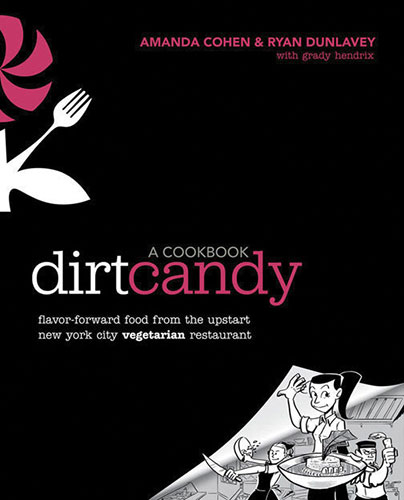
I am excited about Dirt Candy by Amanda Cohen. I love how funny it is and how it’s really a story about her life. The recipes are super easy and good. I bought it directly from Amanda in New York, she’s a super great lady. Even before I got the book, I was doing the recipe for mushroom pâté, to die for. I’ve seen the evolution of that dish, which teaches you to stick with the same recipe. As you get better you can do different things with garnishes or serve it differently. I use Sean Brock’s Heritage a lot. I like The Boreal Feast—it makes me think; wait a second here, we are glamourising all these Nordic men, when you look at the content and depth of wisdom, it’s all in this Canadian book, if maybe the presentation and plating are not.
City Cuisine by Susan Feniger and Mary Sue Milliken was one of my first cookbooks. It showed me real-life women doing what I wanted to do. They were cool, the recipes were like nothing I had ever seen, the combos were so different and I could see myself in them.
Another book that has been highly influential in my career is the River Café Cookbook. I went there. I sat outside in the garden and (chef/co-owner) Rose Gray was sitting on a bar stool at the pass. In conversation with the server I mentioned that I was a cook and she said; ‘Would you like to meet the chef?’ Yes! It was like being in high school!
I just lost a bunch of books stored in my father’s garage to water damage. Some are impossible to replace, including a first edition Mrs Beeton, which was given to me as a gift.
Portabella Pâté with Fennel Marmalade
“The pâté recipe I have been using for a few years now, long before the book came out, but it belongs to Amanda. I use the flexible scotch ice cube trays (big cubes) to mold this, then pop them out and plate with the fennel marmalade and crackers. (I make gluten-free flax ones but didn’t include that recipe as it’s a bit too technical.) I also make a mushroom dirt; it’s a deadly delicious combo.” –Shelley Robinson, Atlas Steak + Fish.
Portabella Pâté
| 1 lb | butter |
| 6 whole | shallots, peeled and finely diced |
| 1 c | heavy (32 per cent) cream |
| 6 whole | portabella mushrooms, chopped, de-gilled and cleaned |
| salt and pepper | |
| 2 t | agar agar (find at health food stores) |
| 2 T | truffle oil |
Sauté the chopped mushroom in ½ the butter, season well and set aside (do not cook until dry, keep moist). Sauté chopped shallots in remaining butter until soft, add cream, bring to a simmer and whisk in agar agar. Place shallots, cream mixture and mushrooms in a blender (work in batches if necessary). Purée well and strain through chinois into mold(s). Set for at least 1 hour. Serve with crackers and fennel marmalade.
Fennel Marmalade
| 2 | whole fennel bulbs trimmed of tops |
| 3 pieces | whole star anise |
| 1 c | white wine vinegar |
| 2 c | water |
| 1½ c | sugar |
| zest of 2 lemons | |
| 2 T | white wine vinegar |
Cut the fennel bulbs in half and remove ⅔ of the woody core and discard. Blanch the fennel in boiling water for 10 minutes, then plunge into ice water immediately. Drain the fennel and dice very small. Bring sugar, star anise, white wine vinegar to a boil. Add fennel and cook over low heat until the mixture has reduced to a syrup consistency, but do not allow to caramelize. Finish with lemon zest and the white wine vinegar. Serve with cheese, pâté or on sandwiches.
Serves 4-6.
ALEXEI BOLDIREFF, BAIJIU
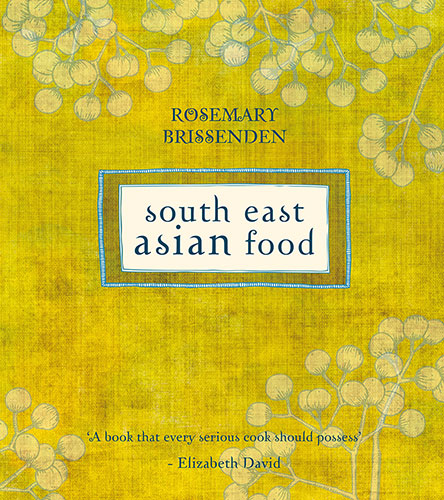
This is actually a difficult question to answer. There are so many books I constantly go back to regularly and on my down time I find myself more often than not with my head in a book.
In regards to Baijiu, it’s South East Asian Food by Rosemary Brissenden. It’s huge, 566 pages and talks about food from all over South East Asia, not necessarily following political boundaries, more geographical. It has been essential in bringing me into south east Asian food. I stumbled upon it in the library when I was working in Calgary years ago.
I do think the majority of a chef ’s knowledge comes from working in good kitchens. My interest in Asian food in general started when I was helping out at Lans Asian Grill. Tom’s mother would grab her mortar and pestle and start making traditional dishes that were not on the menu. She would call me over and explain every detail. That started the ball rolling for me.
Oysters with Lemongrass Mignonette
| 2 T | rice vinegar |
| 2 T | shallot, minced |
| 2 T+1 t | lemongrass, minced |
| 1.5 t | palm sugar |
| 1 T | fish sauce |
| 12 | Nanoose oysters (available from Effing Seafoods) |
Combine ingredients 1-5 and mix well to dissolve sugar. Set aside to infuse. Meanwhile, scrub oysters with a thick brush under cold running water. Shuck oysters using an oyster knife and gently release from the bottom of the shell, saving oyster liquor. Spoon a little mignonette over the shucked oyster on the shell and enjoy!
ERIC HANSON, PRAIRIE NOODLE
My transition to a real kitchen, a fine dining kitchen, was when the sous chef gave me The French Laundry. I was so green, I didn’t know how green. I made the sweet potato agnolotti (page 81) at home, probably still the best dish I have ever made at home. I started carrying a pasta roller in my carry-on. Another book I love is La Mere de la Famille from the Parisian patisserie. I’m not a big dessert guy, so this is the one I turn to when I want to make rochers for my wife. Also Le Cinq by Éric Briffard. It’s really inspiring, with such over the top plating and such contrasting ingredients.
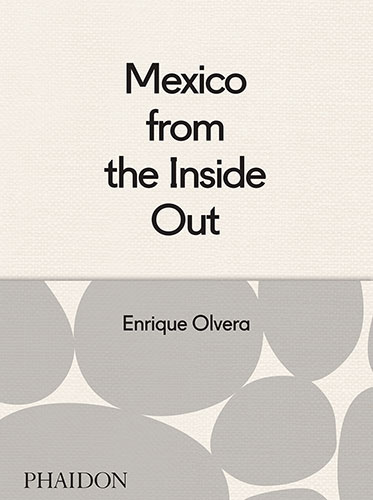
My latest cookbook is Mexico from the Inside Out by Enrique Olvera, probably one of the best chefs working today. A really nice cookbook is like going to an art gallery. It calms my mind and helps me get imaginative. Another inspiration is the food in the TV show Hannibal—it’s really gorgeous.
Spicy Tang, a Daikon Salad
“I taught a Mexi-Thai Class which ended up being more about South East Asian and Central American flavours. Kevin Ostapek and I had a lot of fun with it. We did green curry chicken tomales, smoked pork tostadas with yellow curry crema, cerdo al pastor and a variation on this tasty salad which combines a lot of my favourite ingredients.” –Eric Hanson
Tamarind Dressing
| 4 | Thai chilies, seeds removed |
| 2 lg spoonfuls | palm sugar syrup |
| 2 lg spoonfuls | infused fish sauce |
| 2 | limes, juiced |
| 1 clove | garlic |
| ½ small | shallot |
| 3 spoonfuls | or to taste, tamarind paste, soaked in hot water for 15 minutes |
Mix all ingredients in a blender until it reaches a uniform consistency, approx 2 minutes. Adjust to taste, consider the sweetness of the sugar, spice from the chilies, sour from the lime, bitter from the tamarind, salty from the fish sauce. I like to taste this dressing with my eyes closed and listen for what it needs.
Daikon Salad
| 1 | white daikon, skin removed |
| cherry tomatoes, sliced in half | |
| bean sprouts, rinsed |
Garnish with
| ½ | lime, squeeze over the salad lastly |
| fresh mint leaves, ripped into little pieces | |
| 3 cloves | garlic, sliced thinly fried |
| fried shallots | |
| 1 pinch | katsuobushi (per salad) |
| crispy fried edamame | |
| salad mix |
For the salad, I use a little vegetable peeler with teeth on it, bought for a dollar in Chinatown, a cheese grater also works, or you could slice it into batons or ribbons. Don’t over-think it, either way it will be good. Once you have the daikon in thin pieces, mix it with some cherry tomatoes and bean sprouts. Then add a spoonful of the dressing over it and mix well, taste a small piece and check the heat and flavour, if you want more, add more. In a small bowl add a pile of salad mix and add the garnishes to your liking.
Serves 4-6.
RYAN HOTCHKISS, BÜNDOK
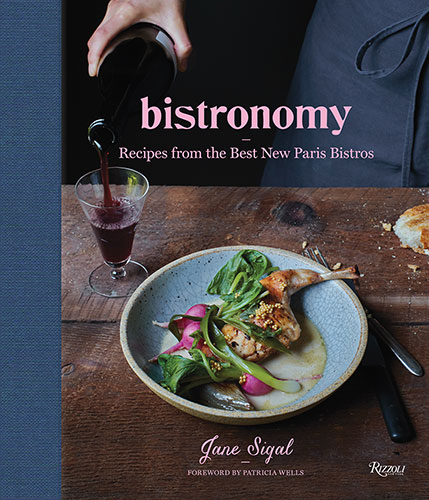
My favourite cookbook right now is Bistronomy. It’s a history of all the Paris bistros—everything from what they look like; how linens and stemware have changed; how much the food is changing there. I was in Paris last year, which is why I bought this book. One thing you notice right away is how small the kitchens are.
One of the first books to influence me when I decided to be a chef was Nobu—super fine dining and plating. Becoming a Chef teaches a way to go about your own personal growth. It has a lot of good information for cooks starting out, such as what chefs look for in a resume.
These cookbooks helped me understand that you don’t know what simple food is until you’ve done the legwork. It’s about the ingredients, why things are done a certain way and how good the ingredients are is so important.
Lamb Stew with Mashed Rutabaga
“This recipe is adapted from Bistronomy. I love rutabaga and it pairs perfectly with the warm spices used in the braise.” –Ryan Hotchkiss
Slow Cooked Lamb
| 4 T | grapeseed oil |
| 1 kg | lamb shoulder, cut into 11⁄2 inch cubes |
| 1 | onion, thinly sliced |
| 2 | shallots or pearl onions |
| 1 stick | celery, chopped |
| 1 | carrot, peeled and chopped |
| 2 cloves | garlic, chopped |
| ⅓ c | malt vinegar |
| 3 sprigs | thyme |
| 2 | bay leaves |
| 1 pod | star anise |
| 1 2-inch piece | cinnamon |
| 1 | clove |
| 3 c | chicken stock |
| ½ c | tomato puree |
| 2 pinches | salt |
Heat 2 tablespoons of oil in a heavy- bottomed saucepan until very hot. Brown all the lamb thoroughly. Remove lamb from the pot and set aside. Discard the oil and season the lamb with salt.
Add remaining oil, then the onion, shallot, celery, carrot, and garlic cloves to the pan. Cook until vegetables have softened and are nicely aromatic, add vinegar and scrape the bottom of the pot, loosening all those tasty brown bits into the liquid. Add thyme, bay leaves, star anise, cinnamon, clove, chicken stock and tomatoes.
Return seasoned lamb to the liquid and cook, covered on the stove at low heat (just enough to see one or two bubbles forming). Cook until fork tender then transfer the lamb to a bowl. Turn heat up and let sauce thicken slightly, about 10- 15 minutes. Return lamb to the pot and season with salt and a little more vinegar if necessary.
Rutabaga Mash
| 2 large | rutabaga (about the size of a softball), peeled and cut into 1½-inch cubes |
| ½ lb | butter |
| water to cover | |
| 1 pinch | salt |
| 1 pinch | freshly grated nutmeg |
| 4 T | butter |
Place ½ pound butter in a medium saucepan and let melt. Add rutabaga, salt and water to cover. Bring to a boil, then drop to a simmer and cook until tender.
Drain cooking liquid and return rutabaga to the pot. Mash rutabaga while adding the 4 tablespoons of butter in stages. Season with salt and freshly-grated nutmeg.
Serves 4.
BRAD SMOLIAK, KITCHEN BY BRAD
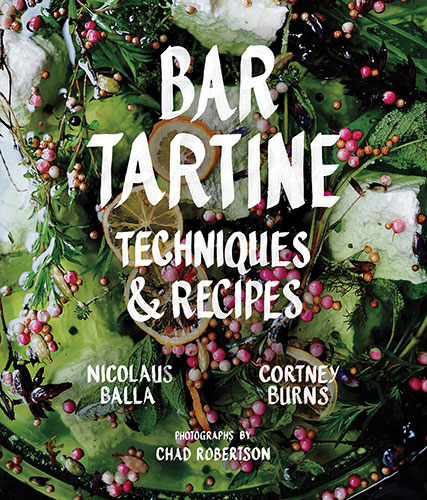
The first cookbook I ever got, I think I was 12, was the NY Times Cookbook by Craig Clairborne. Instrumental in my early career was Jacques Pepin’s Complete Technique and all the books by Harold McGee. Now I’m reading Bar Tartine. It has interesting flavours and vinegars. Also Mamushka, which is a history of food in eastern Europe, not just Ukrainian. It tells how similar they are and how important vegetables were to the culture. The recipes are peasanty but more than pyrohy and cabbage rolls. The other books I use are a series of Time Life cookbooks, one is The Good Cook by Richard Olney, who is one of the best cooks in my opinion. There are probably 30 in the series; I have 24. They are such a great reference. Anytime we have a question about a technique, or need to know how long do you poach that for, or need a reminder about a ratio, we go to them. Great pictures too.
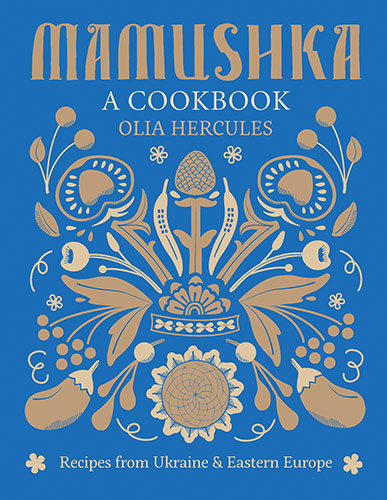
Pasta Carbonara
“We use this recipe for carbonara, out of The Good Cook, at least once a month. You can substitute pecorino from the Cheesiry or Joseph from Winding Road, but it has to be Irving’s bacon.” –Brad Smoliak
| ½ lb | or a bit more spaghetti |
| 2 | eggs |
| 8 slices | bacon, chopped into lardons |
| 2 T | olive oil |
| 1 c | grated Parmesan |
| 1 T | parsley, chopped |
| red pepper flakes, to taste | |
| salt and pepper |
Bring a large pot of water to boil and salt it. Cook the spaghetti until al dente. Cook bacon in a large sauté pan in olive oil, until browned but not too crisp. Remove from heat until pasta is ready.
Meanwhile whisk eggs in a large metal bowl. Mix in cheese, parsley, red pepper flakes, salt and pepper. Drain spaghetti and add to the pan of bacon. Stir until combined and the spaghetti and oil are hot. Add the ingredients in the pan to the egg mixture, stirring immediately until well combined and you have arrived upon a creamy sauce. If necessary, stir while holding metal bowl over heat for a minute. Taste for salt and pepper.
Serves 2.
CHRISTINE SANDFORD, STAFF MEAL, RITCHIE MILL
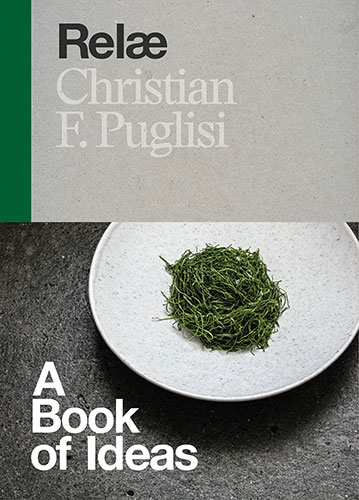
Le Grande Larousse was important for me when I first started cooking. I could look at the pictures of all the varieties of mushrooms or look at a courgette taken apart in all its different pieces. Even now I go back to it. No matter what, it all comes from these traditional recipes and techniques. Technique never gets old. In the last few years the cookbook I have been turning to is the Copenhagen chef Christian F. Puglisi’s cookbook Relæ: A Book of Ideas. My creative energies go crazy when I see the textures they build and I love their use of good quality sustainable products.
DAVINA MORAIKO, RGE RD
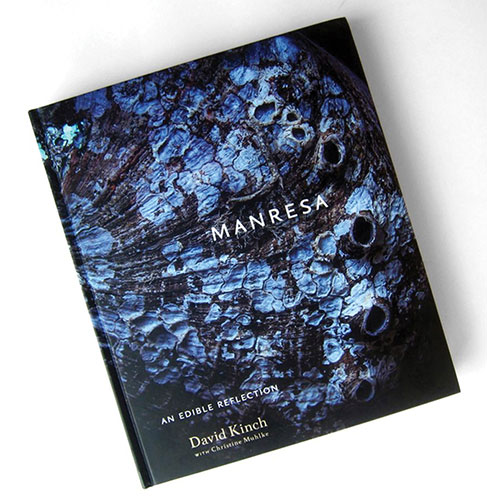
My favorite cookbook in the last few years is Manresa: An Edible Reflection by David Kinch and Christine Muhlke. It is a beautiful book based on San Francisco chef David Kinch and his take on the farm to table movement. I love this book because of the thought put into the dishes and recipes using both traditional and modern techniques and that the passionate chef keeps the connection to the local farmers, people, producers and the land. The book is visually stunning as well. A true farm to table cookbook that is quite inspiring.
Fennel or Onion Jam
“A recipe for creamy nasturtium risotto from Manresa inspired me to make a marigold risotto for our road trip tasting menu at Rge Rd last summer. I also enjoy this fennel jam recipe from the cookbook. It makes a simple savoury jam that I love to spread on toast with a nice soft cheese for a snack. To keep it seasonal I have used onions or beets. You could use chopped lemon verbena and apple vinegar instead of lemon vinegar to make it very local.” –Davina Moraiko, Rg Rd
| 2 | lemons |
| 300 g | simple syrup |
| 3 T | lemon vinegar |
| 2 t | kosher salt |
| 2 med | onions, shaved (or two fennel bulbs) |
Zest and juice the lemons. Combine the lemon juice, simple syrup, vinegar and salt and warm over low heat. Add the onion and cook down over low heat until it develops the consistency of jam. Add the zest and stir. Let cool and reserve. Makes about a cup.
JESSE MORRISON GAUTHIER, THE COMMON, GRANDIN FISH AND CHIPS
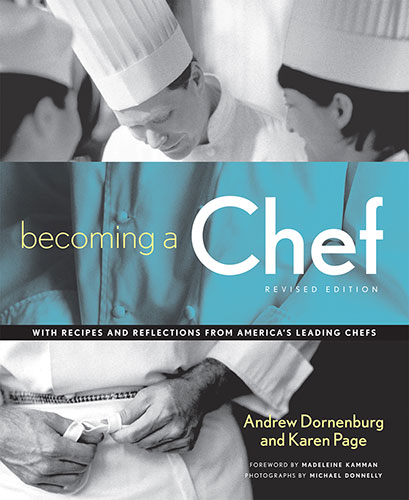
The cookbooks that mean the most have been handed down to me by other chefs. Lyle Beaugard at the Blue Iguana gave me Daniel Boulud’s Letters to a Young Chef. It’s more a set of guiding principles with a few recipes in the back. It’s also nostalgic because I did a stage at chef Boulud’s restaurant in Vancouver, which was a defining moment in my career.
The second most influential book is the Chef’s Compendium of Professional Recipes. It’s the bible, study this book and it’s like going to school for two years. It has all the classic Escoffier recipes, from quenelles to garde manger (cold kitchen) items and all the sauces.
I ask my apprentices and young chefs to read Becoming a Chef by Andrew Dornenburg and Karen Page. It is about the importance of traveling, taking the stairs not the elevator and knowing your place in the kitchen.
Currently I am excited about Bistronomy, which features 20 or so chefs doing bistro food (my passion) in a post elBulli world, focusing on terroir and local ingredients and Edmonton Cooks because it is the first cookbook I was a part of.
Filet of Beef with Raisins and Pepper Sauce
“This is adapted from Daniel Boulud’s Letters to a Young Chef,” –Jesse Morrison Gauthier.
For the Roasted Fingerling Potatoes
| 1T | extra virgin olive oil |
| 1 lb | fingerling potatoes, scrubbed and halved lengthwise |
| 1 T | salt and freshly-ground pepper |
| unsalted butter | |
| 1 clove | garlic, crushed |
| 1 sprig | thyme |
Warm the oil in a large skillet over high heat. When oil is hot, add potatoes and season with salt and pepper. Brown potatoes evenly on all sides, turning as needed. Reduce heat to medium, add butter, garlic and thyme and cook until potatoes are tender. Discard garlic and thyme. Set potatoes aside and keep warm.
For the Sautéed Spinach
| 1½ t | unsalted butter |
| 1½ lbs | spinach, stemmed and centre veins removed |
| 2 cloves | garlic, crushed |
| salt and freshly ground white pepper |
Melt butter in a large skillet over high heat. Add spinach and garlic and season to taste with salt and pepper. Toss until spinach is tender but still bright green, about 5 minutes. Discard garlic and drain off any remaining liquid in the pan. Set aside and keep warm.
For the Beef and Sauce
| ½ c | golden raisins |
| ¼ c | cognac or Armagnac |
| 1 t | coarsely crushed whole pink peppercorns |
| 1 t | coarsely crushed whole green peppercorns |
| ½ t | coarsely crushed whole black peppercorns |
| ½ t | coarsely crushed Szechuan peppercorns |
| 1 whole | Jamaican peppercorn, crushed |
| 1½ lb | beef tenderloin, trimmed of fat and cut into 4 slices |
| coarse salt | |
| 4 T | unsalted butter |
| ⅓ c | unsalted beef stock or low sodium beef broth |
Bring 2 cups of water to boil in a small pot. Add raisins, reduce the heat and simmer for 5 minutes. Drain and run the raisins under cold water. Drain again. Put raisins into a small bowl and pour the cognac over. Cover bowl with plastic wrap and refrigerate overnight. Combine peppercorns together. Season meat with coarse salt and press peppercorns into the beef. Warm 2 T butter in large skillet over medium heat. Slip filets into the pan and cook for 4 to 5 minutes on each side for medium-rare. Transfer meat to a platter and keep warm.
Drain off the fat from skillet. Add raisins and cognac to pan. Simmer gently until liquid is reduced by half. Add beef stock, reduce the heat and simmer for another 2 minutes. Cut remaining butter into small pieces. Gradually add butter to the sauce while continuously stirring. Season to taste for salt. Add meat to the pan and baste with the sauce.
To serve: divide the meat and sauce among four warm dinner plates. Serve with the fingerling potatoes and spinach.
Serves 4.
BLAIR LEBSACK, RGE RD
When I first started cooking and got into my first true apprenticeship it was under Doug Robertson at Dominion Sports Services. Doug had me doing everything from turning potatoes and fluting mushrooms to making all the classic sauces. It was a great way to learn, even if he did make mashed potatoes with my perfectly turned (seven-sided) potatoes. Chef Doug gave me one of his personal cookbooks, a signed copy of The Essential Mosimann. This was my first foray into European cuisine; a very inspirational read. I have read this book cover to cover many times and also purchased the Art of Anton Mosimann as I am now a huge fan of his cooking. This book had served me well but I realized that the best part of this book was sharing it, so I later passed it on to one of my finest apprentices, Drew. I hope that it served him well and has been passed on again.
One of my other favourite cookbooks is Terra: Cooking from the Heart of Napa Valley, just a very nice book that really focuses on technique.
Risotto Anton Mosimann
“I was first introduced to risotto in his cookbook. I love how it is a recipe but also more a way of visually recognizing how to make risotto. On another note, risotto is one of my desert island foods and I would eat this everyday.” –Blair Lebsack
Melt 2 5g of butter in a hot pan. Chop up a small onion into fine pieces and cook it in the butter with a sprig or so of fresh thyme. Cook until soft, but not brown.
Stir in 200 g of arborio rice with a decent pinch of turmeric, and make sure the rice is coated in the hot butter. Again, do not brown.
Pour in 150 ml of steaming hot vegetable or chicken stock. Stir like crazy. The rice will release starch. Starch is what makes the risotto creamy.
Over a medium heat, carry on adding 250 ml of hot stock in small quantities, until the rice has absorbed it. You know how to do this, I don’t really need to tell you: add a bit of stock, stir until most of the stock has been absorbed, add a bit of stock, stir.
As you’re stirring, mix in 250g of courgettes, cut into small diced cubes. I tend to cut up my vegetables for this sort of thing into fairly small dice, as I think, visually at least, it looks neater, and it will take less time to cook.
It’s important not to overcook the rice. The Italians like their risotto rice to be reasonably firm, yet bound in a creamy, fairly sloppy sauce. This is the great art: firm rice, wet sauce; and it’s not especially easy to get right the first time you make it.
Just before you reckon the rice to be ready, pour in 50ml of dry white wine. This will stop the cooking. Stir in a knob of butter, check the seasoning, and serve with freshly grated parmesan cheese.
ROSARIO CAPUTO, CIBO BISTRO
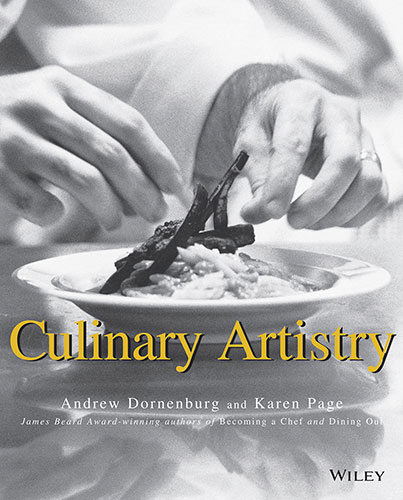
My favourite book to read right now is The Art of Eating Well by Pellegrino Artusi. I have immersed myself in this book. It’s refreshing to read, the simplicity, how innovative he was; these recipes became the classics. Books I find myself always going back to: Made in Italy by Giorgio Locatelli, Marc Vetri’s Rustic Italian Food and The River Cafe Cookbook which was very influential early in my career.
A cookbook that is essential in a kitchen is Culinary Artistry by Andrew Dornenburg and Karen Page. This book is incredible for young chefs as it goes through how to use ingredients, how to pair them seasonally. And, when you are changing the menus as often as we do, it helps keep you sharp. What can we put together? What I do with a fish special?
This book helps the creative process, helps us get an idea of the flavour components.